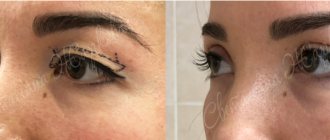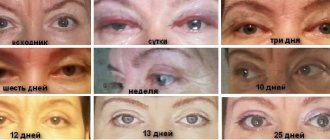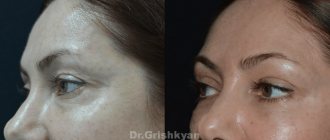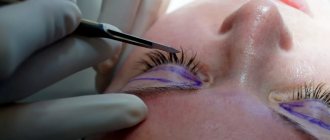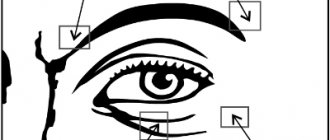Any plastic surgery is a complex procedure, and in each specific case the body may react differently to the intervention. Blepharoplasty is one of the most delicate and complex operations, since the surgeon must not only correct existing age-related changes in the eyelids, but also ensure the aesthetic appearance of the periorbital area without disturbing the aesthetic proportions of the face.
Unsuccessfully performed blepharoplasty can change the face beyond recognition, give the look a sad look, change the shape and shape of the eyes. It must be said that it is often very difficult to correct the changes that have arisen and this requires a number of reconstructive operations.
So what are the signs that indicate unsuccessful blepharoplasty:
- Noticeable scars (high on the upper eyelids and low on the lower eyelids)
- Failure to close eyelids due to deficiency of upper eyelid skin (short upper eyelids)
- Ectropion (shortening of the lower eyelid), the appearance of a strip of sclera under the iris
- Dry eyes, watery eyes
- Eversion of the lower eyelid
- Appearance of scar epicanthus at the inner corner of the upper eyelid
- Presence of residual “hernias” of the eyelids
- Deformation of the shape and size of the palpebral fissure (“round” eye)
“ROUND EYES” EFFECT
The most common mistake that an inexperienced surgeon can make when performing blepharoplasty is to excise too much skin of the lower eyelid. As a result, the so-called “round eye effect” occurs: the eyes look unnaturally bulging, and in the worst case, they do not even close completely. Needless to say, such an effect not only completely spoils the impression of the operation, but also significantly complicates the patient’s life.
Such patients develop watery eyes, dryness and redness of the eyes, and conjunctivitis often occurs. The eyes have an unnatural, “operated” appearance.
Eye asymmetry after blepharoplasty: reasons for its appearance
After the operation, certain complications may occur, one of them is eyelid asymmetry. This phenomenon is quite exciting for the patient and is a reason to contact a doctor. Asymmetry is often caused by changes in eyelid alignment or shape. It is worth noting that this situation can be characterized both as a normal phenomenon and as a complication. Let's find out the possible causes of the defect.
Let us say right away that eye asymmetry after surgery is not such a rare occurrence. After blepharoplasty, many patients note that one eye becomes narrower and the other wider. The cause of an external defect may be changes in tissues, both reversible and not. One of the most common causes is swelling after blepharoplasty. After surgery, swelling can persist for up to six months, depending on the individual characteristics of the body.
The difference in the eyes after surgery is due to uneven accumulation of fluid in the eyelid area. In this case, it seems that the eyelids are located at different heights, and the incision on one side is narrower than on the other. In this case, the defect will disappear as the swelling subsides. Unfortunately, not all reasons are so safe. There are a number of factors that can lead to asymmetry, requiring surgical intervention or additional correction.
Here are the main ones:
- Incorrect structure of the facial part of the skull, both bone structure and soft tissues. In this case, most likely, the asymmetry appeared before blepharoplasty, and after the operation it became more noticeable.
- It is possible that the operating doctor made a mistake during the correction. Not enough or too much skin has been removed, or tendons or muscle fibers have been damaged. Perhaps the stitches were placed incorrectly.
- Ptosis of the upper eyelids. After surgery, due to swelling, ptosis will in any case be present, but with normal rehabilitation it should gradually disappear. If, six months after the operation, the defect has not disappeared, an operation will be required to remove it;
- The presence of rough scars that change the shape of the palpebral fissure or tighten the tissue of the eyelids. It is worth noting that in some cases, the difference between the height of the eyelid folds directly depends on which hand the doctor has the main one. It has been noticed that right-handed people make a more accurate cut on the right side, and vice versa on the left. However, if the scars heal properly, you will not notice any negative consequences, the eyelids will have an ideal appearance.
- With an uneven division of facial expressions, in the case when on one side the muscles are more developed and on the other less. In this case, the peculiarity could have been present in the patient before the operation, but it could also arise as a complication during the rehabilitation period.
REPEATED BLEPHAROPLASTY
However, there is no need to panic in any of these cases. If you have undergone blepharoplasty and it was unsuccessful, in any modern clinic you will be offered a repeat operation. Repeated intervention will help correct inaccuracies made during the initial procedure and provide the result that you originally expected.
The only difficulty is to find a specialist whom you really trust. Because after an unsuccessful operation, patients are usually afraid of repeated failure. Collect information about different clinics, look at reviews of the work of the most famous surgeons, talk with friends who have undergone plastic surgery and are satisfied with the result.
On the website in the appropriate section you can find real patient stories with attached photographs before and after the procedure. And, of course, the surgeon himself will help to fully clarify the situation during an individual consultation.
What to do if you have eye asymmetry after blepharoplasty
Rehabilitation after eyelid correction is different for everyone, it depends on the complexity of the correction performed and the patient’s body. If you follow all the recommendations of your doctor, this period will pass quickly and painlessly. There is a certain algorithm of actions during the recovery period, which has been practiced in many clinics for many years. However, remember that each case is individual, and your doctor may make adjustments to the general recommendations.
The first 2 weeks after blepharoplasty
We strongly recommend that you do not look at yourself in the mirror immediately after surgery. The presence of edema can significantly spoil the mood and drive a weak-nervous patient to despair. Remember, this phenomenon is temporary, swelling tends to disappear slowly and unevenly. Pronounced bruises are also a common occurrence after blepharoplasty. Seams on the eyelids located at different levels can emphasize the asymmetry of the eyes. All these phenomena are not a reason to panic; you should be patient until the physiological changes take place naturally.
Factors that can cause uneven swelling:
- lifting weights;
- work in an inclined position;
- individual characteristics of the location of lymphatic vessels and veins, which are responsible for the outflow of excess fluid from tissues;
- uneven tissue injury, which contributes to the presence of greater swelling on one side of the face;
- sleeping on your side or back;
- failure to maintain drinking balance during the rehabilitation period
2-3 weeks after blepharoplasty, swelling begins to subside. In this case, the eyelids, ideally, should become even. However, the palpebral fissures will not immediately become symmetrical. If you observe a trend in which the right eye becomes similar to the left, the ridges and folds in the eyelid area are smoothed out, and excess water gradually disappears - the recovery process is proceeding normally, and there is no reason to panic. It is worth being as patient as possible and letting the rehabilitation process take its natural course.
div id=”content_rb_84609″ class=”content_rb” data-id=”84609″>
Recovery after lower blepharoplasty
After lower eyelid blepharoplasty, the patient goes home after one day. Rehabilitation proceeds easily and without difficulties. To speed up the recovery process, you should follow the doctor’s instructions for two weeks, namely:
- Do not touch your eyes.
- Replace contact lenses with glasses.
- Don't wear makeup.
- Wear sunglasses outside.
- Apply a cold compress to relieve swelling.
- Limit work on the computer, exclude reading and watching TV.
During the first 3 days, swelling and swelling increases, and small bruises appear. Symptoms disappear within 5-7 days. You are allowed to return to your normal lifestyle after 10 days. If you follow all the surgeon’s recommendations, the likelihood of negative consequences and complications after lower eyelid blepharoplasty is extremely low.
Late complications after eyelid surgery
Some problems after surgery may appear after the rehabilitation period is over:
These include:
- Visible asymmetry of the eyes (appears due to uneven stitches or improper scarring)
- Dehiscence of seams (if not corrected, a rough scar will form)
- Dry keraconjunctivitis (eliminates with special drug treatment)
- The effect of “weathering of the eyes” (this is when the eyelids do not close completely)
- Tearing (caused by improper scarring or edema)
- Blepharoptosis
Most of the undesirable consequences listed above are extremely rare . And can be eliminated by repeated surgery. To minimize the risk, it is important to find a plastic surgeon with extensive experience, carefully consider the process of preparing for surgery and follow the doctor’s recommendations during rehabilitation .
How to remove bags under the eyes?
Age-related changes first become noticeable on the delicate skin of the eyelids. The amount of adipose tissue increases, excess skin sag, a network of wrinkles forms, and the tone of the periorbital muscles decreases. In addition, bags under the eyes, which cannot be hidden under makeup, become a real problem. These changes make you look sad and tired.
Sometimes bags under the eyes can occur in young people and are hereditary. This genetic feature does not please their owners and forces them to look for effective correction methods. In both cases, lower eyelid blepharoplasty will help. Let's talk about this operation in more detail.
Tired of raising your eyelids?
A clear look, an open expression on the face, and its attractiveness are often made dependent on beautiful eyes. They just forget to say that eyes, like precious stones, only play in a good frame.
We're not talking about glasses now. We are about centuries. The shape of the eyes, their correspondence to the general appearance, their beauty, depth and mystery - everything, or almost everything, is determined by how the skin folds around the eye sockets are located.
They have a medical name - palpebra, and a common one - eyelids. There is also a poetic image that best shows that it is the eyelids that sometimes create not only the external image, but also the state of the soul:
Here's how Anna Akhmatova writes about it:
What power does a man have who doesn’t even ask for tenderness! I cannot lift my tired eyelids, When he pronounces my name.
This poetic image very accurately defines the aesthetic problem. Tired eyelids are the upper eyelids, the skin of which has stretched, fatty folds and puffy bags have formed under it. The problem of tired eyelids is not always related to age. Sometimes this is a genetically inherent feature, and then they say about a young woman that she has a hard look.
At the same time, they don’t even suspect how close they are to the truth - it’s really hard for her, this woman, to look from under her always lowered eyelids.
However, the problem is not only women's. Men also suffer from drooping upper eyelids by constantly straining their frontal muscles to lift their eyelids.
This causes tension headaches, large wrinkles on the forehead, fatigue, and a general feeling of facial stiffness.
Will your face change after blepharoplasty?
All manipulations performed during blepharoplasty do not change the facial expression in any way, they simply give facial expressions greater lightness and freedom, rejuvenate and refresh the face.
According to our patients, most friends and acquaintances, meeting them after eyelid surgery, say that they look very good, completely unaware of the fact of the operation.
An experienced plastic surgeon, excising excess skin, opens the eye in such a way that the look is natural, the eyeball is not exposed, and the eyelids close naturally.
Nuances of recovery for various types of blepharoplasty
After upper eyelid blepharoplasty, the recovery period is the fastest. Hematomas occur very rarely. Pain and swelling go away faster than with circumferential blepharoplasty and lower eyelid surgery.
Circumferential blepharoplasty and lower eyelid surgery require a slightly longer rehabilitation period, usually lasting up to 2-3 weeks. Swelling and pain are more pronounced, and bruises under the eyes may be present.
Transconjunctival blepharoplasty is performed through an incision on the inside of the eyelid. It is used only for the correction of lower eyelid defects. The least painful method with a quick recovery period, after which there are no scars.
Preparation for lower blepharoplasty surgery
Any surgical intervention requires preliminary preparation, and lower eyelid blepharoplasty is no exception.
First of all, you need to consult with an ophthalmologist, anesthesiologist and surgeon. To make sure there are no contraindications and reduce the risk of complications, specialists give a referral for a comprehensive examination of the body. Self-preparation begins 10 days before the date of surgery. It assumes:
- Refusal to take anticoagulants.
- Elimination of tobacco consumption.
- Limiting exposure to open sunlight.
List of tests for lower eyelid blepharoplasty

